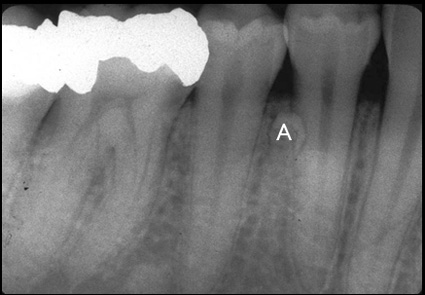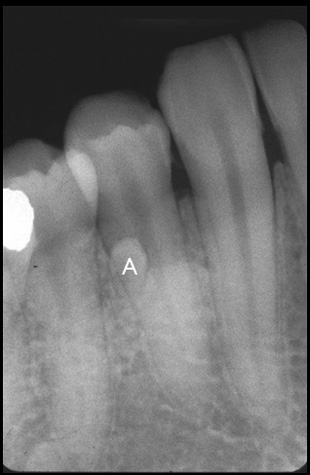Today I will be going over another way to determine the location of an object (known or unknown) that appears on intraoral radiographs. One important note – do not combine the two methods, use only the image shift or the SLOB rule when locating an object.
SLOB rule
The SLOB (same-lingual, opposite-buccal) rule is similar to image shift but the film/sensor must be positioned to the lingual of the teeth to use this method. This will make any object that is buccal/facial of the teeth automatically farther from the film/sensor. The SLOB rule can be used with vertical angle changes; however it is primarily used with horizontal angle changes. Instead of referring to changes with the specific horizontal angle, the images are described in mesial (shows more mesial or anterior objects) or distal (shows more distal or posterior objects) terms. For example, using two radiographs, a premolar periapical radiograph and a molar periapical radiograph, the premolar periapical radiograph would be to the mesial and the molar periapical radiograph would be to the distal. Below is an example with a tiny supernumerary tooth in the mandible and the steps used for this rule.

 1) Using the two images above identify one as image 1 (premolar periapical radiograph) and one as image 2 (canine periapical radiograph).
1) Using the two images above identify one as image 1 (premolar periapical radiograph) and one as image 2 (canine periapical radiograph).
2) You must select two things that are visible on both images – 1) a fixed or known object (mandibular first premolar) and 2) the unknown object (supernumerary tooth labeled A).
3) Now determine which direction the images appear to move from image 1 to image 2 – mesial or anterior.
4) Next determine where the image of the unknown object (label A) moves in relation to the fixed object (mandibular first premolar) from image 1 to image 2 – the supernumerary tooth moves more mesial or anterior than the mandibular first premolar.
5) Using the SLOB rule (same-lingual, opposite-buccal) this shows that the unknown object image moves in the SAME direction as the images (1 to 2) and therefore it is to the lingual of the mandibular first premolar.
This is something that takes practice to get the hang of. I hope these last two posts have broken them down to help refresh or inform you how to use them.
Should you have any questions or thoughts on this topic, please let me know.
Thanks and enjoy!



Hi Dr,
Your wesbiste is very useful.
I have a question with regards to the SLOB rule. What do you mean by move the images? Do you mean you physically move the radiograph after obtainig the image or just the tube and its angulation?
Yes, by moving the images it is referring to having two images with different angulations. As these objects are not really moving in the mouth we are looking at how the images of the objects ‘appear’ to move on the radiographs with different angulations. Please let me know if this helps or you have any other questions. Thanks.
Thank you for the immediate response.
great explanation! can u please explain how it works with change in vertical plane with some examples? this would be really helpful. thanks
I will look for examples using the SLOB rule with vertical angle changes. Please keep a look out for the next few weeks. Thanks.
Thank you for the clear explanation!
very resourceful information
Thanks. 🙂
First thnx fo your great job and helpful information! I just wanna say that the slob method is usefull for horizontal interpretation of buccal and lingual position of stuffs near teeth and is not efficient in vertical position as the rotation axis is different and the result would be the same the two compared stuffs were both buccal or lingual….think about it 🙂 with the kindest regards
The SLOB rule, yes, is primarily for horizontal angle changes but can still be used with vertical angle changes assuming no/minimal change in horizontal angle. When evaluating a vertical angle change, the change in the source of radiation is determined compared to images of the objects in question. It is much more challenging and not ideal, hence I recommend using the image shift principle if only a vertical angle change is evident.
Thanks again!
very good explanation!
Thanks. 🙂
Can slob be used with vertical angulation?
Yes, it can but it can be tricky. Use inferior and superior to help instead of mesial and distal.
Some times clinician would be very careful.
If both the radiographs are not taken in same plan there may problem with object localisation
Moreover technique will be ideal, but only problems occur with tecchnician, patient and tube moment.
Yes, if there is a large variation in the plane of which the images are taken it will mess with this localization so technique is very important. Thanks for emphasizing. 🙂
Good afternoon,
Is it possible for me to utilize some of your radiographs for a textbook chapter I am authoring? These are really good SLOB rule images! Please let me know. Thank you!
I am so satisfied with this site. after so many years now I came to understand SLOB. Thank you very much